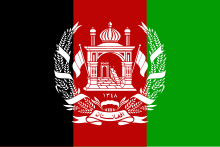 The flag of Afghanistan (1931-2020) | |
| Data | |
|---|---|
| Water coverage (broad definition) | (drinking water): over 67% (2019)[1][2] |
| Average urban water use (L/person/day) | 90 for those with access to piped water in Kabul (2005);[3] much lower for the majority of the population |
| Average urban water and sanitation tariff (US$/m3) | 25 Afghanis (34 US cents) for metered connections; flat rate for unmetered connections (national tariff, in effect since November 2012)[4] |
| Annual investment in WSS | unknown |
| Share of tax-financing | none |
| Share of external financing | very high |
| Institutions | |
| Decentralization to municipalities | Yes |
| National water and sanitation company | National Water Affairs Regulation Authority |
| Water and sanitation regulator | Holding company has regulatory functions |
| Responsibility for policy setting | |
| No. of urban service providers | about 15 |
| No. of rural service providers | thousands of Community Development Councils |
Water supply in Afghanistan is managed by the National Water Affairs Regulation Authority (NWARA), which is based in Kabul, Afghanistan.[5] The nation's water supply is characterized by a number of achievements and challenges. Among the achievements are:
- the expansion of rural water supply infrastructure with the active participation of communities as part of the National Solidarity Program;
- the successful expansion of water supply in the city of Herat and towns such as Kunduz; and
- a reform of the institutional framework for urban water supply through the decentralization of service provision from an ineffective national agency to local utilities managed on the basis of commercial principles.
Challenges include
- the tense security situation, especially in the south and east of the country, that limits the mobility of personnel;
- dilapidated infrastructure as a result of decades of war and neglect;
- a high level of non-revenue water estimated at 40% including water use from illegal connections;
- inappropriate pipe materials such as asbestos-cement used for older pipes;
- a lack of qualified personnel;
- widespread poverty; and
- traditional social norms especially concerning the role of women.
The latter make it hard, for example, to read meters within premises or to involve women in participatory processes.
In urban areas, additional challenges include:
- delays in the procurement of large works, due to a large extent to the absence of contractors with sufficient capacity to execute large works;
- the pollution of shallow groundwater because of a lack of sanitation; and
- poor service quality of piped water supply, including service interruptions that are partly caused by unreliable electricity supply.
- ^ Cite error: The named reference
globalwaters.orgwas invoked but never defined (see the help page). - ^ Cite error: The named reference
unicef.orgwas invoked but never defined (see the help page). - ^ Calculated based on a water production of 60,000 m3 per day, 30,000 connections, 33% physical losses and 15 persons per connection
- ^ Cite error: The named reference
KfW Heratwas invoked but never defined (see the help page). - ^ "National Water Affairs Regulation Authority". Retrieved 2021-03-20.